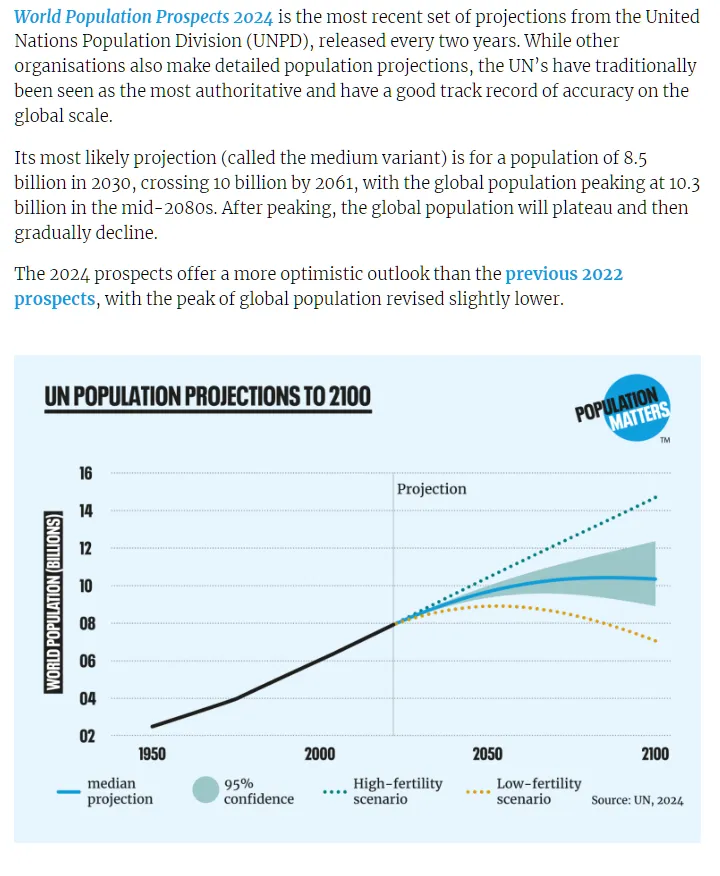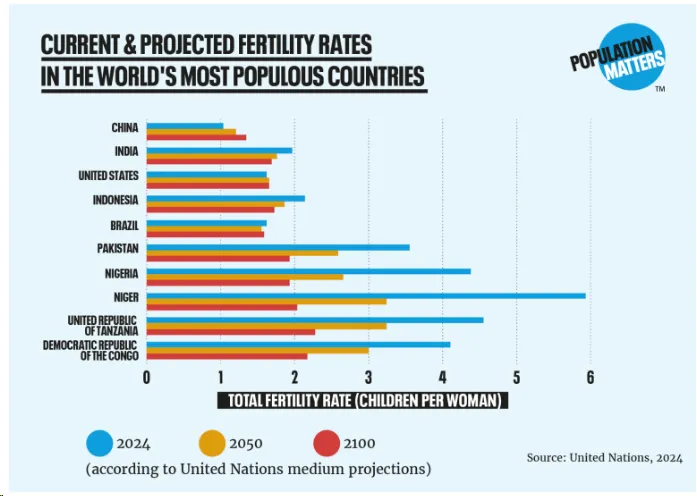Preface: This 1500-word essay is motivated by the sense of hope I found for the human species' survival in the next century in demographers' population forecasts. I note that the global human population is likely to decline after 2080 and could reach long-range sustainable levels by 2150. Pro-natal programs to prevent this decline, now being promoted in some countries, are unlikely to succeed. Also, very importantly, the population decline is not socially/politically forced, but instead proceeds from the free choices of women and men to have fewer children, with the earliest and most rapid adjustments happening in the wealthiest nations. While many social, political, and economic changes are required to reach a sustainable future for humans and the overall Ecosystem, the expected decline of the human population from 8-10 billion to 4-5 billion provides a foundation for hope, which can relieve the sense of doom so many now feel. In the concluding paragraphs of the essay, I call for more work on conceiving and inventing an economy that will serve all equitably in the period of declining population. In that regard, there is much work to do. ~ Charles Knight
July 11th, I am told, is World Population Day [1] Who knew? I didn’t.
For a few years now, I have been meaning to write about how declining fertility rates, particularly in some of the world’s most prosperous countries, are the best news for reducing and reversing the increase in atmospheric CO2, perhaps saving the human species while it saves the planet.
In January of 2023, I read a guest essay in the New York Times entitled Women in South Korea Are on Strike Against Being ‘Baby-Making Machines’ by South Korean journalist, Hawon Jung.
In the article’s second paragraph, she writes:
A 2022 survey found that more women than men — 65 percent versus 48 percent — don’t want children. They’re doubling down by avoiding matrimony (and its conventional pressures) altogether.
[The next paragraph opens:] The trend is killing South Korea.
Full stop! I am taken aback that the author is framing her story in a way that makes women’s choices the enemy of South Korean national interests: There is a “crisis” of falling fertility rates in Korea that is an existential threat to the nation-state! Really? I am highly skeptical.
I knew that the then-new right-wing government in South Korea was making an issue of declining marriage and fertility rates, but why does this avowed feminist journalist accept without question that the forecast population decline represents a major threat to the nation? Hawon Jung is critical of the right-wing pro-natalist policies of the government. In response, she advocates:
Motivating Korean women to reconsider marriage and children involves infusing every aspect of their lives with agency and equality.
I fully support the feminist struggle for every aspect of women’s lives [having] agency and equality. At the same time, a forecast of declining population in the USA, Germany, South Korea, Australia, or Japan (all high-income countries) should be welcomed. It is precisely what our Earth needs to avoid ecological disaster. It is also entirely consistent with women’s rights and power in society.

Source: Population Matters.
Click on the image to enlarge.
I grew up in the 1950s. They called my generation Baby Boomers. Since then, the global population of humans has tripled, reaching 8.2 billion this year. That is a fantastic increase in one lifetime. Far, far greater than that experienced by any previous human generation.
Humans are wonderful, and babies are amazing. They (the young and the old) are also frequently selfish, needy, and irritating. No wonder the traffic in the city and on the highways is terrible, the government is too often annoying, and the planet is heating up. At the same time, many living things suffer and die off.
There are ecological notions of population overshoot and carrying capacity. How they apply to the human population is, as we should expect, contested. [2] My sense of the consensus for human carrying capacity from the studies I have read is that a long-term sustainable human population on the Earth is about twice the 2.5 billion humans on the planet the year I was born (1946). Thus, a long-term sustainable human population, assuming ongoing improvement in production and consumption practices, is between 4 and 5 billion (the level of 1980).

Source: Population Matters.
Click on the image to enlarge.
By the end of this century, UN forecasts indicate the global population will be declining. Perhaps by 2125 (100 years from now), we will be approaching a sustainable population level. Meanwhile, the environment and many species of living things will suffer greatly. Let’s hope that during the next 100 years of transition, we will be collectively wise enough to avoid mass starvation and mass war deaths from becoming significant factors in a hastening of the population decline.
Population decline is only one aspect of solving the environmental crisis. Still, its prospects are immensely encouraging. It will help dissipate the despair associated with the fear of the human species’ extinction. This effect should not be underestimated.
Perhaps population decline will also contribute to motivating serious attention to building a theory and practice of creating equitable human-serving economies suitable to, first, a declining and, secondly, a stabilizing global population. If, in the coming decades, humans can progressively become more careful and skilled in sustainable production, distribution, and consumption, then it should be possible to have (once the population declines to 4-5 billion) a slowly growing population of humans without destroying our common home.
The essentially voluntary nature of this projected decline in population is very welcome. It is not similar in any way to a program of government or NGO-led population control. When tried, population control is cruel, coercive stuff, usually with racist and sexist aspects.
The forecast population decline is very different. It is essentially voluntary because people of reproductive age will decide on their own whether to get pregnant while considering career and job opportunities, other life interests, housing availability, etc. It's not that different from what a portion of Earth’s young people (such as youth in South Korea and Japan) deal with today.
The present opposition to population decline is mainly from influential elites in states such as the USA, Japan, and South Korea. Among other things, they are often in favor of incentivizing women to marry early, they seek to deny birth control and sex education to women and men, and, in general, they aim to reinforce patriarchal relations between the sexes. This coalition is primarily led by finance capital. They believe that their income and wealth depend on an ever-growing national GDP, structurally linked to population size and likely to decline as the population declines.
The national GDP level is not a matter of concern to most people. If such a measure is at all useful, [3] it is GDP per capita. [4] It is mostly those who make their living by taking a percentage of national financial transactions who worry about the total national GDP.
It is possible and necessary to create a good economy that can make a smooth transition to a smaller population. It won’t be easy, yet it is a problem easier to solve than seeking to mitigate the environmental disasters that surely await us with hyper-capitalism obsessively seeking national growth, even as populations decline.
I hope that I have sparked your interest. Perhaps a few of my readers may take up a piece of the puzzle of how to make this necessary transition in human behavior and societies, so that we avoid the worst of ethno-nationalism and the associated morbidities of the various reactionary ideologies.
Almost certainly, our societies will need to move in the direction of much greater equality, in many cases making use of progressive income and wealth taxation, as well as livable-level minimum wages and social incomes. The growing inequalities over the last forty years have exacerbated the environmental crisis, making it more complex and challenging to repair.
Before I close this little essay, I will mention one specific area of theory and practice in which we already have considerable experience. It will need much more attention in the coming years. The experience I refer to is in dealing with geographic areas of economic decline in market economies. Local and regional instances of decline are a frequent phenomenon, often associated with technological change, greater in some periods than others. Towns become redundant (in the British usage of the word) as large employers exit, followed by the migration away of younger workers seeking employment. The age composition in these towns gets older more quickly than the country overall.
I sense that the fixation on national growth in the field of Economics completely overshadows consideration of the economics of declining populations. In the coming period of GDP stasis or decline in step with population decline, much more study is needed of the theory and practice of achieving a human-serving ‘good’ economy.
Please be in touch with your thoughts, as well as references and resources for theorists and activists.
Notes
[1] World Population Day was an initiative of the United Nations begun in 1989. World Population Day, according to associated literature, focuses on:
[2] The range of estimates of carrying capacity is remarkably large, reflecting very different assumptions regarding the meaning of the notion. This is a brief review of the studies: https://www.niussp.org/environment-and-development/can-earth-support-4-billion-people-sustainably-and-well/
[3] The measure of national GDP “externalizes” (does not account for) non-market domestic labor or environmental costs (unless those costs are ‘paid’ by polluters compelled to mitigate them within the market).
[4] Interesting, isn’t it, how major media rarely report GDP per capita, while changes in total national GDP show up almost daily in the press.